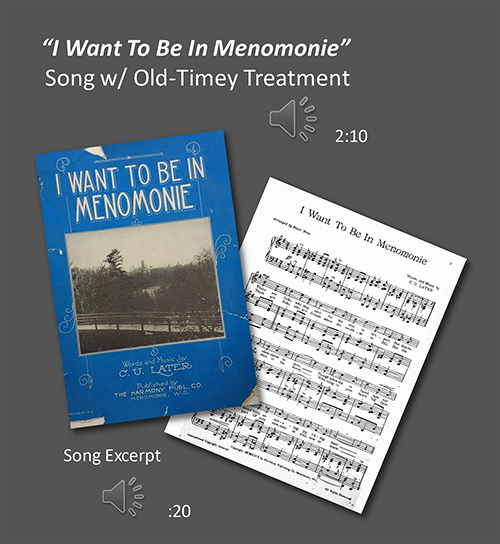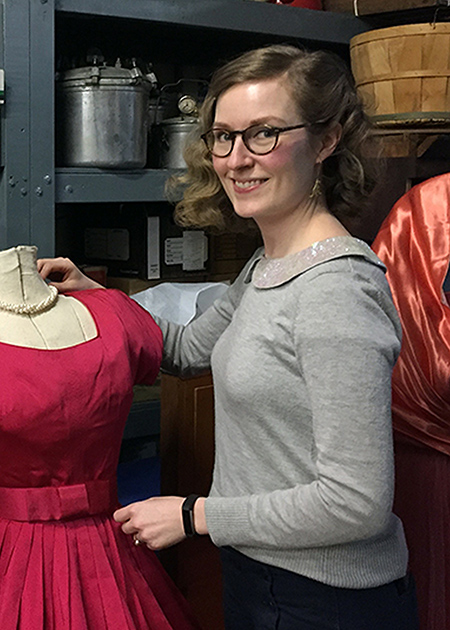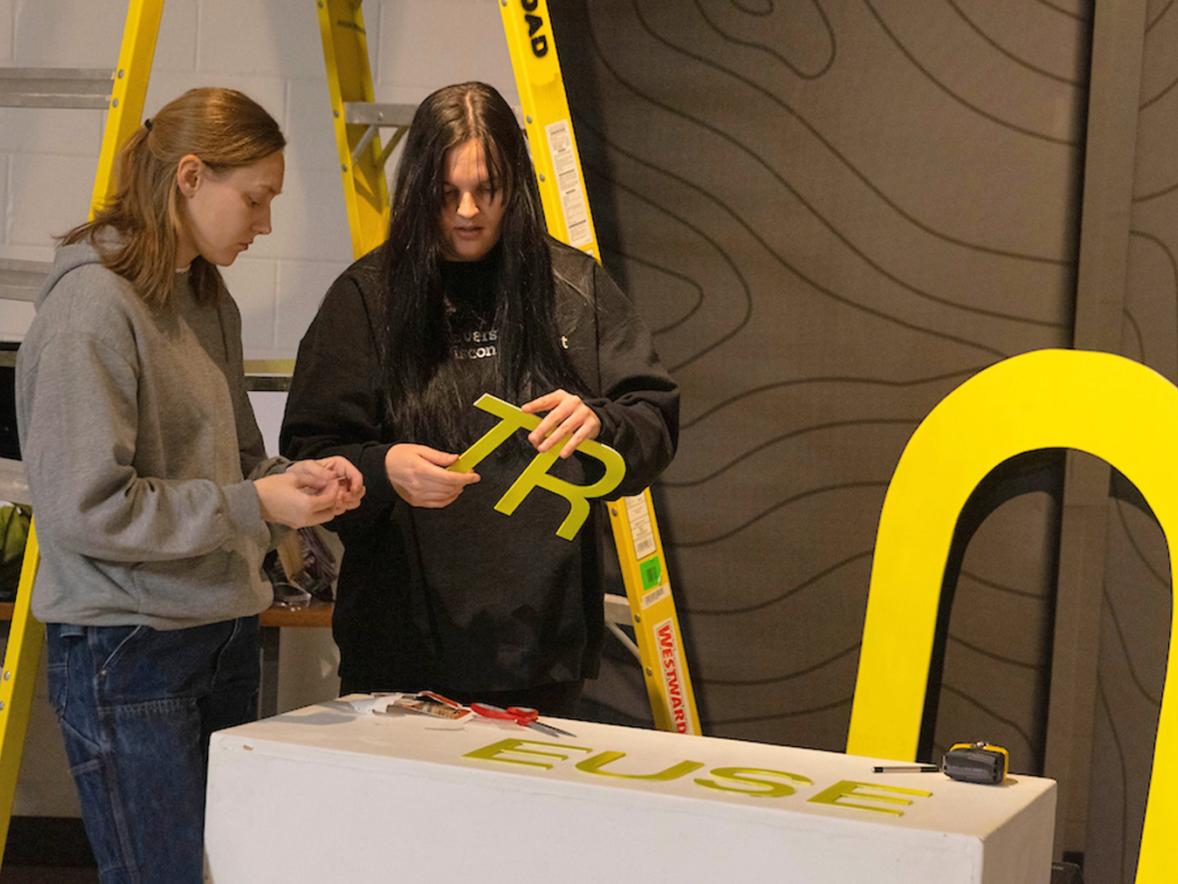Students from UW-Stout's Master of Fine Arts in design program spent the spring semester collaborating with the Dunn County Historical Society to find design opportunities that address challenges facing small-town museums.
Following interviews with Melissa Kneeland, executive director of the historical society and Russell J. Rassbach Heritage Museum and Fulton’s Workshop, the class engaged in brainstorming sessions to identify opportunities for development. Students were drawn to the idea of "relevance" in the 21st century, finding new ways to strengthen connections with Dunn County, including general patrons, donors and UW-Stout faculty, staff and students.
 Recently, the seven graduate students presented their findings and proposals to Kneeland, accompanied by Don Steffen, vice president of the historical society board of directors, and UW-Stout Archivist Heather Stecklein.
Recently, the seven graduate students presented their findings and proposals to Kneeland, accompanied by Don Steffen, vice president of the historical society board of directors, and UW-Stout Archivist Heather Stecklein.
"I was impressed and excited by the projects," Kneeland said. "The students brought fresh perspectives and diverse ideas — helping us to see possibilities for continued relevance to our community through design thinking."
A student team of Jon Alesch, Bloomer, Karl Koehle, Minneapolis, and Jessica Kromrie, Minneapolis, addressed the issues of donations, funding and engagement. The team conducted surveys with patrons, which prompted them to look at improving the organization's existing donation framework. Their proposal took a layered approach and included an online donation system, a suite of print materials to engage with donors and patrons, and a proposal for an educational podcast. The three elements were bundled into a holistic development plan.
Koehle, who is also an instructor in the UW-Stout design department, noticed some vintage sheet music for a song titled "I Want to Be in Menomonie" sitting on the piano in the museum. Realizing there was no way to hear the song, Koehle input the music to a digital format and recorded himself singing along, as a form of audio preservation. To listen to the recording, go here.
“My proposal demonstrates that audio recordings for podcast delivery, such as this catchy tune from 1929, could reach a broader remote audience, advertise upcoming events, help preserve stories and drive traffic to the website to help increase donations,” Koehle said.
The team of Benita Close, River Falls, Jackie Cummings, Bemidji, Minn., Lei Feng, St., Paul and Jackson Yang, Menomonie, uncovered a desire for more university-related content, indigenous content and interactive displays. The group proposed interactive displays to help present the museum's content.
Close and Feng worked with Stecklein to source content for a digital display kiosk with an interactive timeline of the history of UW-Stout. Cummings and Yang proposed Indigenous History Hunt, an interactive game projected onto a tabletop focusing on the history of the indigenous people of Dunn County. Both concepts embrace technology and patron-driven content.
"We found that folks on campus were interested in exhibits about the history of indigenous peoples in the area, and there was interest for those exhibits to be interactive in some way," Cummings said. "Unlike tablet displays, this exhibit is less likely to be damaged by rough visitors because the only piece of equipment they interact with is a plain, sturdy table."
The display would also be easy to clean to minimize health risks, the team noted.
Erik Evensen, associate professor and program director for the MFA in design, who taught the Research Strategies in Design class, said the students went above and beyond with their work.
“The kiosk and interactive display proposal was pretty aspirational but would be an incredibly engaging addition to the museum,” Evensen said. “The strategic plan consisting of branding, web applications and podcasts was intentionally designed to be within reach and modular enough that any one piece could be implemented without the others. That wasn't a project requirement, but it's commendable that the team took that approach.
 “When you collaborate with an organization outside the university, it has an incredible impact on the way students approach research. It really grounds their approach and the way they present their findings. Also, the community impact can drive students' creativity," Evensen said.
“When you collaborate with an organization outside the university, it has an incredible impact on the way students approach research. It really grounds their approach and the way they present their findings. Also, the community impact can drive students' creativity," Evensen said.
The students presented many wonderful, practical and well thought out ideas, Kneeland said.
“We are definitely taking aspects of many of the projects into consideration as we move forward,” Kneeland said. “For example, creating a way for our members to donate to us online is a major short-term project that we had been looking into, and the students outlined how and why this is so important, as well as researching what they thought would be the best platform for us to utilize.”
Having students develop ideas and share them allows the museum to benefit from new ideas, Kneeland said. “Although as a museum our focus is history, we must remember to look to the future to ensure we are staying relevant and up-to-date in our methods of engaging with the public,” she said. “We are fortunate to have community-minded professors at the university that seek to help local nonprofits, while also utilizing the real-world learning opportunities they provide.”
Midway through the semester, the students found themselves changing their research plans because of the COVID-19 pandemic. With UW-Stout classes moved to alternative delivery methods, many contemporary research methods were no longer available.
"We went old-school," Evensen said. "We conducted surveys and interviews, and we embraced secondary research methods. We sourced articles, conducted literature reviews and created personas based on the demographics of our research. The class projects cited 40 different books, articles and interviews.”
In addition to the Master of Fine Arts in design, the School of Art and Design programs include entertainment design, game design and development, graphic design and interactive media, industrial design, interior design and studio art.
###
Photos
Images of the “I Want to be in Menomonie” sheet music by C.U. Later in 1929.
Melissa Kneeland
Erik Evensen





